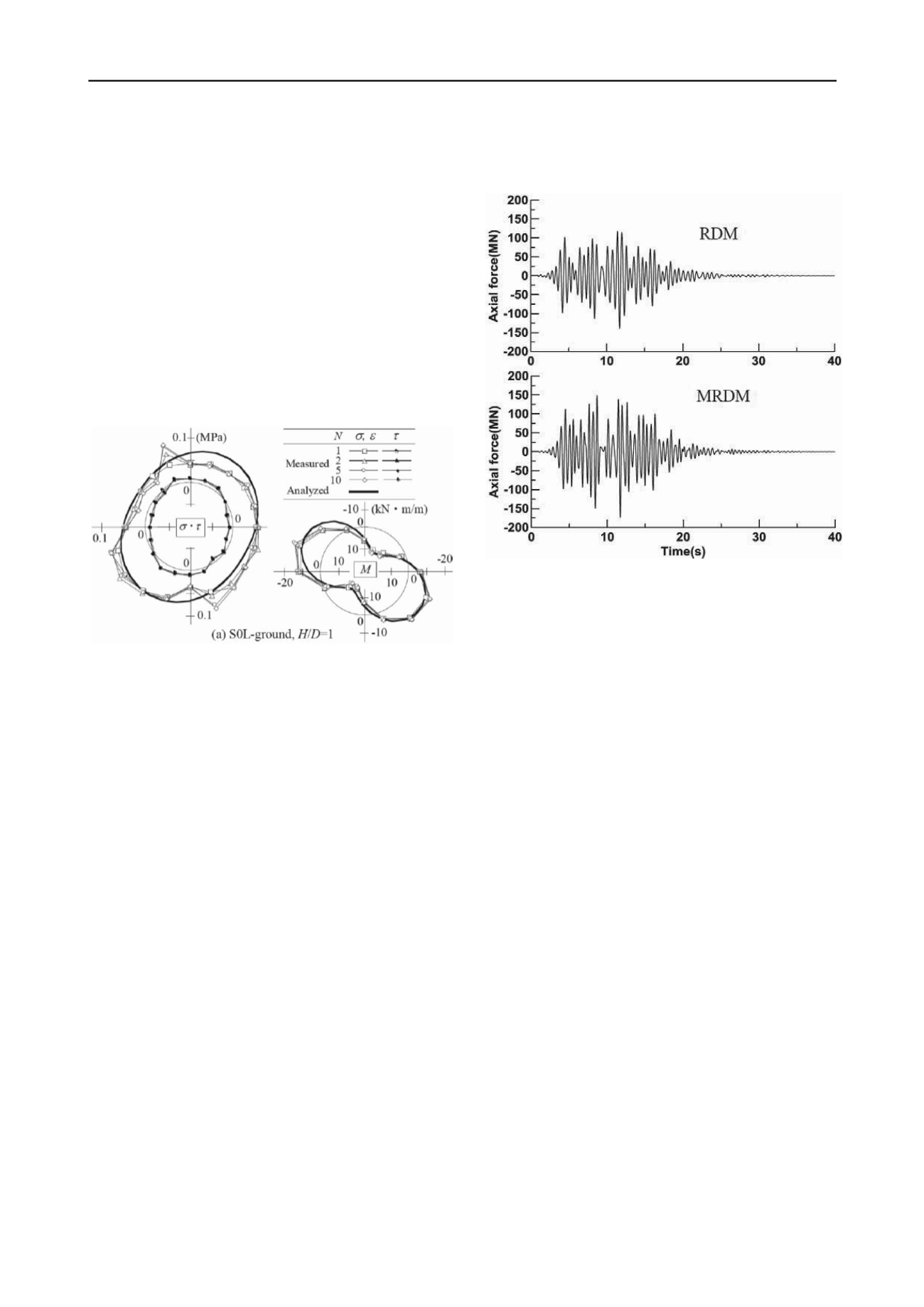
1679
Technical Committee 204 /
Comité technique 204
points over the short comes of design codes when it comes to
seismic forces.
Tohda
et al.
in their paper “An elastic continuum model for
interpretation of seismic behaviour of buried pipes as a soil-
tion, modelled as a
structure interaction” propose an analytical method for 2D
analysis of buried pipes under seismic ac
simple shear action due to an earthquake. The objective was to
overcome the current design code methodology that
recommends the use of the seismic deformation method, based
on spring models. This method assumes a governing stand for
the tangential stress in the seismic behaviour.
The results were compared with the proposed model
predictions with the results of a series of centrifuge model tests,
as in Figure 19, confirming the validity of the analytical model.
The results indicate that in most cases the tangential stress is
almost null. The proposed model gives a rational interpretation
for the seismic soil-pipe interaction with a proper account of the
main stress components.
Figure 19. Comparison between measured and analytical results of
normal and tangential stress and bending moment (after Tohda
et al.
).
Huang and Liu
present a new modified response
displacement method (MRDM) in the frequency domain, in
their paper “Fast frequency-domain analysis method for
longitudinal seismic response of super long immersed tunnels”.
The method is based on the theory of dynamic elastic Winkler
foundation beam and is applied to analyse the longitudin
seismic response of a sea-crossing immersed tunnel between
e
tun
al
Hong Kong, Zhuhai and Macao (HZM) in China, as in the paper
from Xie
et al..
The proposed method considers the inertia of th
nel, soil-tunnel interaction parameters and the dependence of
dynamic stiffness coefficients on external loading frequency.
The results are compared to the regular response displacement
method (RDM), as in Figure 20. The HZM tunnel was modelled
by 253 particles and the results indicate that the deformations of
joints at both sides of the tunnel are much larger than those in
the middle of the tunnel, which is analogous to that of the axial
force. Nevertheless excessive tension and compression will not
occur under proper design of segment joints.
Botero
et al.
in their paper “Effect of the subsoil conditions
in the seismic interaction between two underground stations
connected by a circular section tunnel” study a 50 year horizon
of a 9 m diameter tunnel section connecting two metro station at
about 22 m depth. They considered the seismic environment of
the region scaled by the construction code of Mexico City. The
present soil parameters as well as the prediction of their time
evolution due to regional subsidence were evaluated in terms of
CPT tests and empirical correlations to estimate the shear wave
velocity. The results of a 3D finite difference numerical
modelling indicate that only after 30 years the effects of the
effective stress changes will present a considerable increase in
the tunnels displacement and stresses. This would enable a
better planning of future interventions and maintenance of the
tunnel structures.
The papers present the challenges of the very complicated
and potentially hazardous phenomena of earthquakes.
Development of an analytical model, when confirmed by
experimental data as in
Tohda
et al.
, is of great value for daily
engineering practice.
Figure 20. Comparison of the time history of axial force at one cross
section of the immersed tunnel obtained by the RDM and the MRDM
(after Huang and Liu).
7 CONSTRUCTION TECHNIQUES
Two papers were assigned to this topic. They present an
evaluation of the selection procedure for construction methods
truction method for highway underground
crossing transit on the deposit soils in urban project in Korea”
n of a low depth road
the ground conditions
r the selection of the optimum construction method
fo
ical data assessment.
modelling a real case in soft
co
and a new construction technique called modular approache
tunnelling.
Yang and Yoo
in their paper “Case studies of applicability
for selection of cons
d
present a case history of the constructio
tunnel under a highway in Korea were
were worse than predicted and remediation measures were
necessary.
This case study underlines the argument that a rational
guideline fo
r an underground project is needed. Such a guideline would
enable predictions of possible construction problems and
improve the reliability of the financial budget. They also defend
the case that design standards should specify the retention
period of history files of structures, a standard coded system for
underground failure types and a mandatory reliability analysis
for geotechn
Komiya
presents an analysis of a new construction method
called modular approached tunnelling in his paper “Finite
element modelling of construction processes of the modular
approached tunnelling method”. This method was developed to
construct large scale tunnels for cross passages. The method
consists of a cycle of small mechanized excavation followed by
box-module insertion to form a lining frame in the soil that will
sustain the excavation of the soil within the frame.
The process was analysed by
hesive soil in Tokyo by 3D FEA (Figure 21). The mesh of the
numerical model was updated at each time step and fictional
elements to represent the cutting face of the TBM were
employed.
The expected settlement of the numerical model was larger
than the measured value, as in Figure 22, but the shape of the
computed settlement trough at the top of the lining frame was
similar to the measured results.


